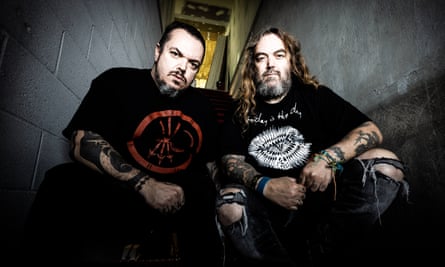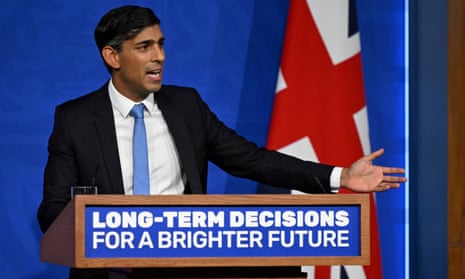UPDATED
‘The support feels good’: UAW members embrace Biden and shrug off TrumpIn Fort Wayne, Michigan, union autoworkers react to Biden showing up to pledge his support and to Trump avoiding them
Tom Perkins in Wayne, Michigan
Tue 26 Sep 2023
On a damp and windy day, members of the United Auto Workers (UAW) picketed outside a sprawling Ford plant in Wayne, Michigan, burning logs in barrels for warmth.
The plant makes the Ford Bronco, and workers there were among the first to strike when union contract negotiations between the UAW and the car companies collapsed earlier this month.
Strikers wearing red shirts and carrying signs chanted: “What do we want? Contract! When do we want it? Now!” and “No pay no parts,” as drivers passing by on the busy highway blared their horns in support.
The UAW strike has pushed into its third week, and unlike many strikes, it has managed to stay in the news – not least because on Tuesday, Joe Biden became the first US president to join strikers on a picket line in what feels like the unofficial kick-off to the 2024 campaign season.
“Stick with it. You deserve a significant raise,” Biden told the crowd in a minute-long speech. “We saved them [the car companies]. It’s about time they step up for us.”
The speech may have been short and sweet but the reaction was overwhelmingly positive.
Walking the picket line, Larry Hearn, a 61-year-old UAW committee member, said: “We’re out here on the frontline taking the brunt for everybody, losing money. The support feels good. We don’t need him to get in our business and secure us a contract, but his support is enough. It hits home with people.”
The Donald Trump campaign called Biden’s visit to the picket line a “cheap photo op”, but at least some workers disagree with that assessment.
“It’s about time a president stood up for workers instead of the billionaire class and donor class,” said Quintin Tucker, 57, who works in the plant’s final assembly department.
Trump will visit a non-union auto shop tomorrow, a fact that was not lost on those outside the Wayne plant.
“That’s where his loyalties lie,” Walter Robinson, a 57-year-old quality inspector, said. “If he wants to be with working people who are struggling, then he would be here. I don’t know who he is playing for – is he playing for working people, or corporations?”
“He has to go to a non-union plant because if he came here, we wouldn’t let him in,” added Hearn. “If he pulled up in his motherfuckin’ motorcade right now, we would not let him in.”
But it’s too early to count Trump out, said Robinson. The former US president did beat Hillary Clinton in the state in the 2016 election and still has his fans.
Trump gets a lot of support among union members because of “guns, gays and taxes”, Robinson said, and inflation has not helped Biden.
“That resonates with a certain sector of people,” he added, estimating that there is about a 60-40 split at the plant in support for Biden and Trump respectively.
Hearn said he is a Democrat and that most union members will say they are, but added, “You never know what someone is going to do when they get behind the booth.”
Frank Wells, a 27-year plant veteran, is a Democrat who is not impressed by Trump, especially because he is visiting a non-union shop.
“Let’s be real. He doesn’t support what we’re doing. He’s corporate. He’s a billionaire, a businessman, but we’re out here fighting for our lives,” Wells said.
Tucker estimates support for Biden and Trump in the plant is closer to 50-50, and that Trump draws support for his “cult of personality” and effective use of social wedge issues.
Trump does not really support the UAW, Tucker said, because “he is from the billionaire class and it’s against his interest”. Still, he added: “People vote against their economic interest in favor of cultural issues.”
He scoffed at Trump’s planned visit to a non-union shop. “The anger that we’re feeling right now - he doesn’t want that to rub off on him so he went somewhere safe, where they don’t have any skin in the game.”
Hearn said he is a Democrat and that most union members will say they are, but added, “You never know what someone is going to do when they get behind the booth.”
Frank Wells, a 27-year plant veteran, is a Democrat who is not impressed by Trump, especially because he is visiting a non-union shop.
“Let’s be real. He doesn’t support what we’re doing. He’s corporate. He’s a billionaire, a businessman, but we’re out here fighting for our lives,” Wells said.
Tucker estimates support for Biden and Trump in the plant is closer to 50-50, and that Trump draws support for his “cult of personality” and effective use of social wedge issues.
Trump does not really support the UAW, Tucker said, because “he is from the billionaire class and it’s against his interest”. Still, he added: “People vote against their economic interest in favor of cultural issues.”
He scoffed at Trump’s planned visit to a non-union shop. “The anger that we’re feeling right now - he doesn’t want that to rub off on him so he went somewhere safe, where they don’t have any skin in the game.”
UAW strikes: Biden visits picket line as Ford pauses Michigan battery plant
Pras Subramanian
·Senior Reporter
Updated Tue, September 26, 2023
A momentous day arrived for the United Auto Workers (UAW) union and its ongoing strike with the Big Three as President Biden joined the picket lines in Michigan, just as Ford (F) announced a big update on an upcoming battery plant in the state.
Biden met with UAW picketers at GM's Van Buren Township parts distribution center in Michigan. "Wall Street didn’t build this country, the middle class built this country. The unions built the middle class," Biden said to UAW workers on strike. "Let’s keep going, you deserve what you’ve earned. And you’ve earned a hell of a lot more than you’re getting paid now."
UAW president Shawn Fain joined Biden at the picket line as well, thanking the president for joining the strike, but stopped short of endorsing Biden ahead of the 2024 presidential election.

U.S. President Joe Biden speaks next to Shawn Fain, President of the United Auto Workers (UAW), as he joins striking UAW members on the picket line outside the GM's Willow Run Distribution Center in Bellville, Wayne County, Mich., Sept. 26, 2023. (Evelyn Hockstein/REUTERS) (Evelyn Hockstein / reuters)
The White House says Biden’s visit was the first time a sitting president has visited a picket line in modern times. The move comes as his Republican rival, former President Trump, indicated he would be visiting the state as well. On Wednesday, Trump is expected to hold a rally with 500 former or current union members in Clinton Township, Mich.
The Big Three — Ford, GM, and Stellantis — put out statements ahead of Biden’s visit, though they did not criticize the president for joining the UAW strikes.
“On the first day of the strike, President Biden said UAW workers ‘deserve a contract that sustains them and the middle class.’ We agree and presented a record offer,” Stellantis (STLA) said on its UAW negotiations website.

President Joe Biden joins striking United Auto Workers on the picket line, in Van Buren Township, Mich. (Evan Vucci/AP Photo) (ASSOCIATED PRESS)
GM (GM) also stated that its “focus is not on politics but continues to be on bargaining in good faith” with the UAW to reach an agreement.
Ford also issued the statement on the president’s visit, which notably is where the company’s big Michigan Assembly Plant is located. “Ford and the UAW are going to be the ones to solve this by finding creative solutions to tough issues together at the bargaining table. We have a shared interest in the long-term viability of the domestic auto industry, the industrial Midwest and good-paying manufacturing jobs in the US,” the company said.
Ford also made waves on Monday when the automaker announced that it is pausing development on its $3.5 billion battery plant in Marshall, Mich., claiming the automaker had concerns about “competitively” operating the plant.

Ford Motor Company executive chair Bill Ford announces Ford will partner with China-based Amperex Technology to build an all-electric vehicle battery plant in Marshall, Mich., during a press conference in Romulus, Mich., Feb. 13, 2023. (Rebecca Cook/REUTERS) (Rebecca Cook / reuters)
Ford declined to say what specifically changed in its planning, but the company stated it has not made a final decision on the planned investment at the site. Note that Ford is partnering with China’s CATL to license CATL’s LFP (lithium iron phosphate) battery tech for new EVs. Ford had said in the past that it would own the battery plant, and would employ all the workers, but it is possible guidance on battery credits Ford would receive from the government changed due to Ford’s licensing agreement with CATL, leading to the pause in development.
Nonetheless, the UAW pounced on Ford’s decision, claiming it was a move to punish the union and union jobs, because of the UAW’s ongoing demands for higher wages.
“This is a shameful, barely veiled threat by Ford to cut jobs,” UAW's Fain said in a statement. “Now they want to threaten us with closing plants that aren’t even open yet. We are simply asking for a just transition to electric vehicles and Ford is instead doubling down on their race to the bottom.”
Pras Subramanian is a reporter for Yahoo Finance. You can follow him on Twitter and on Instagram.
Pras Subramanian
·Senior Reporter
Updated Tue, September 26, 2023
A momentous day arrived for the United Auto Workers (UAW) union and its ongoing strike with the Big Three as President Biden joined the picket lines in Michigan, just as Ford (F) announced a big update on an upcoming battery plant in the state.
Biden met with UAW picketers at GM's Van Buren Township parts distribution center in Michigan. "Wall Street didn’t build this country, the middle class built this country. The unions built the middle class," Biden said to UAW workers on strike. "Let’s keep going, you deserve what you’ve earned. And you’ve earned a hell of a lot more than you’re getting paid now."
UAW president Shawn Fain joined Biden at the picket line as well, thanking the president for joining the strike, but stopped short of endorsing Biden ahead of the 2024 presidential election.
U.S. President Joe Biden speaks next to Shawn Fain, President of the United Auto Workers (UAW), as he joins striking UAW members on the picket line outside the GM's Willow Run Distribution Center in Bellville, Wayne County, Mich., Sept. 26, 2023. (Evelyn Hockstein/REUTERS) (Evelyn Hockstein / reuters)
The White House says Biden’s visit was the first time a sitting president has visited a picket line in modern times. The move comes as his Republican rival, former President Trump, indicated he would be visiting the state as well. On Wednesday, Trump is expected to hold a rally with 500 former or current union members in Clinton Township, Mich.
The Big Three — Ford, GM, and Stellantis — put out statements ahead of Biden’s visit, though they did not criticize the president for joining the UAW strikes.
“On the first day of the strike, President Biden said UAW workers ‘deserve a contract that sustains them and the middle class.’ We agree and presented a record offer,” Stellantis (STLA) said on its UAW negotiations website.
President Joe Biden joins striking United Auto Workers on the picket line, in Van Buren Township, Mich. (Evan Vucci/AP Photo) (ASSOCIATED PRESS)
GM (GM) also stated that its “focus is not on politics but continues to be on bargaining in good faith” with the UAW to reach an agreement.
Ford also issued the statement on the president’s visit, which notably is where the company’s big Michigan Assembly Plant is located. “Ford and the UAW are going to be the ones to solve this by finding creative solutions to tough issues together at the bargaining table. We have a shared interest in the long-term viability of the domestic auto industry, the industrial Midwest and good-paying manufacturing jobs in the US,” the company said.
Ford also made waves on Monday when the automaker announced that it is pausing development on its $3.5 billion battery plant in Marshall, Mich., claiming the automaker had concerns about “competitively” operating the plant.
Ford Motor Company executive chair Bill Ford announces Ford will partner with China-based Amperex Technology to build an all-electric vehicle battery plant in Marshall, Mich., during a press conference in Romulus, Mich., Feb. 13, 2023. (Rebecca Cook/REUTERS) (Rebecca Cook / reuters)
Ford declined to say what specifically changed in its planning, but the company stated it has not made a final decision on the planned investment at the site. Note that Ford is partnering with China’s CATL to license CATL’s LFP (lithium iron phosphate) battery tech for new EVs. Ford had said in the past that it would own the battery plant, and would employ all the workers, but it is possible guidance on battery credits Ford would receive from the government changed due to Ford’s licensing agreement with CATL, leading to the pause in development.
Nonetheless, the UAW pounced on Ford’s decision, claiming it was a move to punish the union and union jobs, because of the UAW’s ongoing demands for higher wages.
“This is a shameful, barely veiled threat by Ford to cut jobs,” UAW's Fain said in a statement. “Now they want to threaten us with closing plants that aren’t even open yet. We are simply asking for a just transition to electric vehicles and Ford is instead doubling down on their race to the bottom.”
Pras Subramanian is a reporter for Yahoo Finance. You can follow him on Twitter and on Instagram.
























